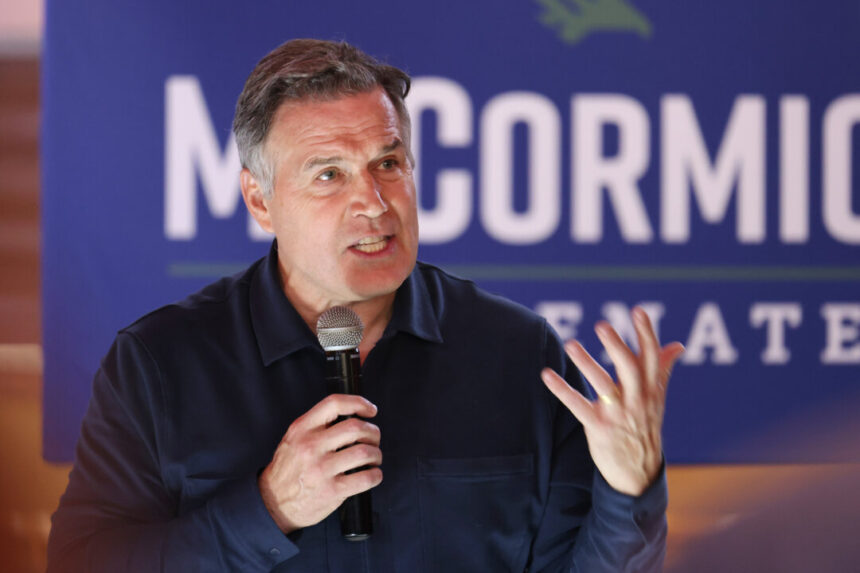Commentary
It is just after 9 p.m. on election night in an oversized suite on the 24th floor of downtown Pittsburgh’s Fairmont Hotel. All the couches and cushioned chairs have been placed along the wall and replaced by around a half dozen campaign staffers working at desks, or makeshift desks, watching data start to pour in from across Pennsylvania. In the center of it all sits Dave McCormick, looking at a monitor with his wife, Dina Powell, hovering over him, her arm on his shoulder.
It is a tender moment captured in the middle of a chaotic scene.
It’s early, and McCormick, Republican Senate challenger, is behind incumbent Sen. Bob Casey (D-Pa.) at this moment, but there appears little panic. In fact, they are smiling. So are Mark Harris and Brad Todd, McCormick’s top campaign advisers. Harris is looking at a whiteboard with counties scribbled across the top, and Todd is pacing, looking at his iPhone. Elizabeth Gregory, McCormick’s press secretary, is on the phone. Matt Gruda, McCormick’s campaign manager, is watching the results as the Republican challenger starts to grab a very slim lead.
By midnight, they all know McCormick will win, as they have suspected for the past month. However, it would take the Associated Press two days to call it and Casey two weeks to concede a race very few analysts thought the three-term Democrat could ever lose to a candidate his team believed was an easy target.
McCormick and his team believed otherwise.
So how did a West Point graduate from Bloomsburg, Pennsylvania, go from losing an agonizingly close, contentious Republican Senate primary two years ago to Dr. Mehmet Oz to winning against Casey, whose family has been a Pennsylvania political institution for four decades? It all began with focus and an interview conducted in his Pittsburgh living room days after he lost that first race.
At the time, McCormick said he was unsure if he would try another race.
Within just over a year, he was in. The first thing he did was what many CEOs do when forming a board of directors: He formed a team of professionals from very different backgrounds and experiences who had never worked together. This is a risky business in politics, where a campaign team usually comes as a package deal.
Harris, the Pittsburgh-based chief strategist, was hired first. He came from the political orbit of former Pennsylvania Republican Sen. Pat Toomey. Todd, whom McCormick dubbed “the chief storyteller,” was hired on Labor Day 2023. He came from the world of Republican Sens. Rick Scott (Fla.), Josh Hawley (Mo.), and Thom Tillis (N.C.). Gregory and Gruda were strategists for Sen. Marco Rubio (R-Fla.).
Todd, a Tennessee native and founding partner of OnMessage who coauthored “The Great Revolt: Inside the Populist Coalition Reshaping American Politics” in 2018, said it’s impossible to overstate the importance of their team not having a contested primary.
“That is all a testament to Dave’s nature and his work ethic,” said Todd. “He did not get mad and let people who weren’t for him become enemies from the first race. He just kept working on relationships.”
In those early days traveling across the state, you could see McCormick sitting down and listening to people who did not support him. He never acted like anyone owed him anything, even though it would have been easy to adopt an “I told you so” pose after Oz lost badly to Sen. John Fetterman (D-Pa.) in 2022. He also engaged in small, off-year elections for local offices, thus building more relationships.
Then came the hard part: how to run against a man who, with the exception of one primary race for governor in 2002, had won handily in every statewide race he had run, including for state auditor general, state treasurer and the Senate. Add the kicker that Casey had the same name as his late father, a beloved centrist Democrat governor of the state. From 30,000 feet, a win against Casey seemed daunting.
Todd said he and Harris found out really quickly in research that Casey’s strength was overstated.
“He was a mile wide and an inch deep,” explained Todd. “A lot of people were familiar with his name, but nobody was familiar with anything he had done or was working on doing.”
In short, Casey had no political equity.
Todd said it is rare to see a politician who has broad name recognition and no equity, “especially after as long a career as he had. But beyond knowing that he was in office, he really started with nothing. On the negative side (in terms of campaigning against him), he also did not have any established negatives.”
No one was ready to throw Casey out, but no one knew how to rally around Casey to keep him in.
Todd explained that was the tricky part of the campaign.
“So we had to accept early on that people were not going to hate Bob Casey or think Bob Casey was terrible, so we had to construct a strategic framework that let voters vote for Dave without being mad at Bob,” he said.
One key thing they had to do was invest cash in introducing McCormick.
Todd explained that sometimes you beat incumbents by just piling on their negatives, something he said he’s done in certain races.
“But because Casey didn’t start with a lot of negatives and we knew he would have unlimited money, we did not think that it was possible to beat him with negatives alone,” he said.
Hence, the positive portrayal of Dave and his values was deemed crucial. Meanwhile, Todd criticized Casey for his loyalty to President Joe Biden and later Vice President Kamala Harris, noting that the administration’s unpopularity was evident. Despite this, McCormick’s campaign was pleased when Biden withdrew from the ticket, as they believed linking Casey to Harris would benefit them. They were the first campaign to do so, using an ad featuring Casey endorsing Harris’s extreme views. This strategy proved effective in showcasing Casey’s alignment with the far left. Despite Casey’s financial advantage, McCormick’s team strategically waited until September and October to match funds. Additionally, Mark Harris’s strong understanding of the state’s resources was instrumental in the campaign’s success. The support of Keystone Renewal, led by Sean Parnell, was also crucial in securing victory. Parnell’s efforts helped add new voters to the permanent vote-by-mail list, benefiting Republicans. Despite initial skepticism from race handicappers, McCormick’s path to victory became clear as the presidential race shifted away from Harris and Casey. The coalition that supported Trump also supported McCormick, reflecting a growing conservative populist movement. Todd believes that as voters become more familiar with Dave, his appeal will continue to grow. McCormick’s victory was attributed to his leadership and embodiment of Pennsylvania values. His family history and West Point background were highlighted in the campaign, portraying him as a dedicated servant of the country. The campaign’s final ad, filmed at West Point, emphasized the transformative impact of the institution on McCormick. Understanding a candidate’s motivations is key in persuading swing voters, who may lack strong opinions on political matters. Or they possess conflicting ideological viewpoints.
The deliberate strategy of targeting voters in key Pennsylvania counties like Luzerne, Bucks, Montgomery, and Philadelphia proved to be successful in swaying swing voters towards McCormick. Ultimately, voters went with their instincts based on their perceptions of the candidates’ motives, leading to McCormick’s victory.
Please note that the opinions expressed in this article are solely those of the author and may not necessarily align with The Epoch Times’ views.
Source link







